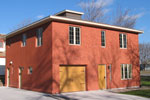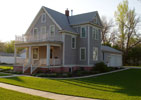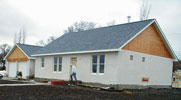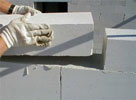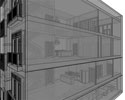Affordability
- Overview
- Materials
- Maintenance
- Energy Costs
By the term “affordability” we mean more than a person of X income can purchase the home. We are referring to two concepts. First, pairing complementary materials and designs can produce homes that cost less than 30 percent of virtually any family income. Second, over the life of the home our buildings are less expensive to build and maintain. The key is simplicity and quality. Cutting corners in the short term only creates higher costs in the long run.
We are not striving to builds ultra modernist uncomfortable art. Instead our utmost concern is the comfort and well being of the occupants of the home. We achieve this goal through innovative materials and designs, which work in the background, out of the conscience of the occupant.
Would you believe it is possible to build a house that is virtually impervious to insects, rodents, mold, fire, wind and sound, and yet is less expensive to build than standard construction? Autoclaved Aerated Concrete, AAC for short, is part of the equation. While it has a complex name, it is actually a very simple material. AAC is steamed cured concrete with thousands of tiny air pockets. The steam reduces the length of time it takes to reach full strength from one month to less than one day. The air bubbles are created with a simple chemical reaction, which causes the concrete to foam as it cures. Air bubbles make up to 80 percent of the volume of AAC. The trapped air helps insulate the building from heat differences and from sound.
As residential property values rise across the country it is easy for current homeowners to loose sight of the impacts on non-homeowners. Appreciating real estate values make it more expensive to buy and rent. Younger and lower income individuals and families are often unable to accumulate adequate down payments, lack sufficient credit history or are simply priced out the market. The result is that they fall further behind as property values appreciate. Today even traditional middle-income families are finding it more difficult to own their own home.
The challenge is to develop housing affordable to these individuals. In some cities where housing values are rises much faster than the salaries of the middle class, the cities are instituting subsidy programs for teachers, police officers and firefighters so that they are able to live the jurisdictions they serve.
Two main alternative ways to increase affordability include increasing housing density and reducing construction costs. Townhouses and row houses divided into multiple condominiums are simple ways to increase housing density. Increasing density can reduce residents’ comfort due to closer proximity and noise.
Buildings built with AAC walls and integrated concrete floor systems are an effective option for dealing with the inconveniences of increased density. AAC and properly design concrete floors can significantly reduce noise transmission between adjoining dwellings.
AAC reduces costs in several ways. First, it contains only about ¼ to 1/5 as much material as a solid concrete wall because of the tiny air pockets. Second, AAC construction requires only the AAC block and thinset mortar, a stucco coat on the exterior and a plaster coast on the interior. Scheduling conflicts for subcontractors are virtually eliminated, especially if conduit for electrical wiring is placed in the wall during while laying block. In contrast, typical wood construction requires 2x6 studs, exterior sheathing, house wrap, siding, paint, insulation, gypsum board, sheetrock joint compound and tape, more paint, and lots of nails and screws and caulking. An experienced AAC block layer can lay about 200 square feet of block per day. An inexperienced homeowner can lay about 100 square feet per day.
AAC and integrated cement floor construction creates highly fire resistant self-contained dwellings. This allows the elimination of redundant sidewalls between buildings. Economies of scale increase quickly. For example, excluding the cost of land, a single 18x100 feet three-story row house can be built for about $70,000 per unit ($210,000) for the whole building. Alternatively, if three of the buildings just mentioned are built side-by-side, the cost per unit drops to under $60,000.
One route envisioned for meeting this goal would bring 3 or 4 potential homeowners together at the beginning of the process. Each would invest $25,000 to $50,000 up front in a 6 to 8 unit building. Their initial investment would guarantee them the option to buy a unit at the development cost (land, materials, labor, operating overhead) so that they would be able to realize the property value appreciation.
A second goal is to streamline the construction process for future projects, which will improve profitability and finished product quality. Increasing profitability while maintaining high quality standards will allow us to sell the condominiums at lower prices, thus achieving our third goal: affordability.
Background (How we got here)
As discussed in the Concepts section, affordability is one of our primary considerations in choosing materials and architectural styles. Affordability should not equate to poor quality.
Taking houses apart and putting them back together has significantly shaped our design intuition. One of the benefits of remodeling houses is that it forces you confront and solve a variety of challenges related to materials and layout. We remodeled a turn of the century farmhouse twice, first updating and then adding more space. We then turned to remodeling a 1916 Victorian kit house and a 1930’s bungalow. The bungalow with a central stairway efficiently divided private and public parts of the house. The major drawback of the bungalow we remodeled was the size of the bedrooms. The house’s 24 feet width provided functional, but not comfortable bedrooms.
In the summer of 1999 we read about autoclaved aerated concrete (AAC) in Fine Homebuilding (#123, pp. 82-87) The article is available at http://www.taunton.com/finehomebuilding/pages/h00002.asp “Building for Affordability and Energy Efficiency,” by Kathleen Jardine and James Cameron). We were intrigued by the material and wanted to test it in the cold South Dakota winters.
Today in rural America it is difficult to sell new houses for more than $75,000 because of the number of older, cheaper houses. While the older houses are not ideal, they can be insulated and painted for less than building from scratch. Our challenge was thus to build a better quality house and still be economically competitive. The house we built in 2000 served as a test bed for AAC and concrete floor construction in South Dakota. In the end the house we built cost significantly more than our goal. Much of the additional cost was due the second story dormer and roof system, and an oversized garage. The lessons learned from that project have been incorporated in the following projects.
